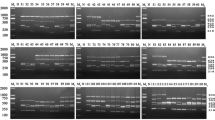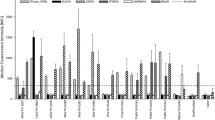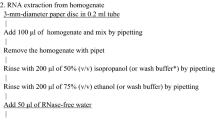Abstract
We improved a one-step multiplex reverse transcription-polymerase chain reaction (multi-PCR) method previously published for the simultaneous identification of five tospovirus species that mainly occur on Solanaceae and Compositae plants. The multi-PCR system is composed of a universal degenerate primer and five virus-species-specific primers that amplify bands unique to Iris yellow spot virus (837 bp), Tomato spotted wilt virus (709 bp), Impatiens necrotic spot virus (589 bp), Chrysanthemum stem necrosis virus (485 bp), and Capsicum chlorosis virus (366 bp). This technique is potentially useful for epidemiological studies of several tospoviruses that have recently been detected in previously uninfected fields of ornamental crops.




Similar content being viewed by others
References
Chu F-H, Chao C-H, Chung M-H, Chen C-C, Yeh S-D (2001) Completion of the genome sequence of Watermelon silver mottle virus and utilization of degenerate primers for detecting tospoviruses in five serogroups. Phytopathology 91:361–368
Doi M, Kato K (2002) New virus diseases in lisianthus caused by Iris yellow spot virus (IYSV) and Impatiens necrotic spot virus (INSV) (Abstract in Japanese). Jpn J Phytopathol 68:231
Doi M, Zen S, Okuda M, Nakamura H, Kato K, Hanada K (2003) Leaf necrosis disease of lisianthus (Eustoma grandiflorum) caused by Iris yellow spot virus. Jpn J Phytopathol 69:181–188
German TL, Ullman DE, Moyer JW (1992) Tospoviruses: diagnosis, molecular biology, phylogeny, and vector relationships. Annu Rev Phytopathol 30:315–348
Goto T, Sazarashi H, Nozawa H, Nakayama K, Natsuaki T (2001) Necrotic spot of cyclamen and exacum caused by Impatiens necrotic spot virus (INSV) (Abstract in Japanese). Jpn J Phytopathol 67:173
Hull R (2002) Genome organization. In: Hull R (ed) Matthews’ plant virology, 4th edn. Academic Press, San Diego, pp 171–224
Iwaki M, Honda Y, Hanada K, Tochihara H, Yonaha T, Hokama K, Yokoyama T (1984) Silver mottle disease of watermelon caused by Tomato spotted wilt virus. Plant Dis 68:1006–1008
Kato K, Hanada K, Kameya-Iwaki M (1999) Transmission mode, host range and electron microscopy of a pathogen causing a new disease of melon (Cucumis melo) in Japan. Ann Phytopathol Soc Jpn 65:624–627
Kawano T, Takahashi K, Takahashi Y, Tairako K, Tsukamoto S, Kobayashi Y, Honda Y (1999) Spotted wilt disease of verbena, Madagascar periwinkle and impatiens caused by Tomato spotted wilt virus (Abstract in Japanese). Ann Phytopathol Soc Jpn 65:651
Matsuura S, Hoshino S, Hayashi H, Kohguchi T, Hagiwara K, Omura T (2002) Effects of latent infection of stock plants and abundance of thrips on the occurrence of Tomato spotted wilt virus in chrysanthemum fields. J Gen Plant Pathol 68:99–102
Matsuura S, Kubota K, Okuda M (2007) First report of Chrysanthemum stem necrosis virus on chrysanthemums in Japan. Plant Dis 91:468
Mumford RA, Barker I, Wood KR (1996) The biology of the tospoviruses. Ann Appl Biol 128:159–183
Nichol ST, Beaty BJ, Elliott RM, Goldbach R, Plyusnin A, Schmalijohn CS, Tesh RB (2005) Genus Tospovirus. In: Fauquet CM, Mayo MA, Maniloff J, Desselberger U, Ball LA (eds) Virus taxonomy. Eighth Report of the International Committee on the Taxonomy of Viruses. Elsevier, San Diego, pp 712–716
Okuda M, Hanada K (2001) RT-PCR for detecting five distinct tospovirus species using degenerate primers and dsRNA template. J Virol Methods 96:149–156
Okuda M, Takeuchi S, Komi K, Iwanami T (2005) Occurrence of chlorosis on pepper (Capsicum annuum) caused by Capsicum chlorosis virus (Abstract in Japanese). Jpn J Phytopathol 71:235
Rozen S, Skaletsky HJ (2000) Primer3 on the WWW for general users and for biologist programmers. In: Krawetz S, Misener S (eds) Bioinformatics methods and protocols: methods in molecular biology. Humana Press, Totowa, pp 365–386
Taba S, Naito T, Takaesu K (2000) Necrotic yellow disease of New Zealand spinach (Tetragonia expansa Murr.) caused by Watermelon silver mottle virus (WSMV) (Abstract in Japanese). Jpn J Phytopathol 66:146–147
Takeuchi S, Okuda M, Hanada K, Kawada Y, Kameya-Iwaki M (2001) Spotted wilt disease of cucumber (Cucumis sativus) caused by Melon yellow spot virus. Jpn J Phytopathol 67:46–51
Tanina K, Inoue K, Date H, Okuda M, Hanada K, Nasu H, Kasuyama S (2001) Necrotic spot disease of cineraria caused by Impatiens necrotic spot virus. Jpn J Phytopathol 67:42–45
Thompson JD, Higgins DG, Gibson TJ (1994) CLUSTAL W: improving the sensitivity of progressive multiple sequence alignment through sequence weighting, position-specific gap penalties and weight matrix choice. Nucleic Acids Res 22:4673–4680
Tsuda S, Hanada K, Fujisawa I, Kameya-Iwaki M, Tomaru K (1994) The demonstration of strain-specific antigenic determinants on nucleocapsid of Tomato spotted wilt virus by monoclonal antibodies. Ann Phytopathol Soc Jpn 60:216–220
Uga H, Tsuda S (2005) A one-step reverse transcription-polymerase chain reaction system for the simultaneous detection and identification of multiple tospovirus infections. Phytopathology 95:166–171
Acknowledgments
We are grateful to L. M. Knight for critically reading this manuscript. We thank Y. Matsumura and S. Nagai for the preparing and maintaining the plants.
Author information
Authors and Affiliations
Corresponding author
Rights and permissions
About this article
Cite this article
Kuwabara, K., Yokoi, N., Ohki, T. et al. Improved multiplex reverse transcription-polymerase chain reaction to detect and identify five tospovirus species simultaneously. J Gen Plant Pathol 76, 273–277 (2010). https://doi.org/10.1007/s10327-010-0246-1
Received:
Accepted:
Published:
Issue Date:
DOI: https://doi.org/10.1007/s10327-010-0246-1




